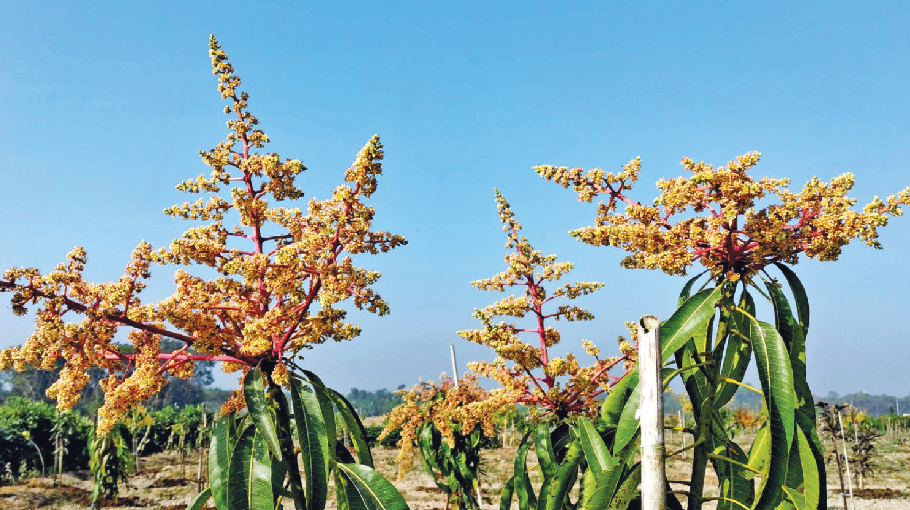Mango trees in first buds smell sweet

Mango trees across the country are adorned with bunches of flowers and their sweet smell pervades in every corner of the country. About 90 percent of the mango trees have already bloomed and the flowering still continues ahead of the advent of ‘Falgun’ – the first month of the last Bengali season.
Growers in the country are hopeful of a bumper yield of the sweet juicy fruit this season if the weather continues to remain favourable in the next few months.
However, the sandy and polluted air is hampering the mango flowers. Huge mango trees are being engulfed with the dusts, which might cause low yielding of the mangos. Mango growers and traders have already started taking care of the mango trees aimed at making good business. Farmers have started spraying pesticides on the trees to ensure protection of the crop.
Mango, which is a seasonal fruit, is cultivated across the county. But the northern region is the main place where most of the mangos are yielded. There are varieties in the mangos. Of them, Khirshapati, Mohna, Rajbhog, Rupali, Amrapali, Langra, Gopalbhog, Surjapuri, Asiyana, Chhatapara, Fazli, Chini Falzli, Surmai and Misribhog are the main among the types.
Harvesting of this fragrant juicy fruit usually starts in mid-April (Boishakh, first month of Bangla calendar) and continues till early October.
There are thousands of large and small mango orchards in the country. The cultivation and trade of the popular fruit is a blessing for rural economy as it creates job employment and business opportunities for a large number of people every season.
According to scientists and agriculture officials, mangoes are the most important cash crop in the region and that the livelihood of a large number of people are dependent on the fruit. A good number of people remain engaged in different jobs, including nursing, harvesting and packing, during the mango season every year.
On the other hand, Chittagong Hill Tracts have become the new fruit hub.
About 38 thousand small and large-scale entrepreneurs are now involved in fruit farming in these three districts. And now 44 different types of fruit including mango, banana, jackfruit, papaya, pineapple and oranges are being grown in the hill tracts -- three hill districts -- Rangamati, Bandarban and Khagrachhari.
According to the Department of Agricultural Extension (DAE), about 15 per cent of the total fruit produced across the country comes from these three hill tract districts now. Fruits grown on the hills are now available in different districts across the country including Dhaka and Chattogram.
Fruit farmers, agriculturists, businessmen and common consumers of these three districts believe, fruit farming in Chittagong Hill Tracts is increasing due to political stability, switching to permanent orchards from Jhum cultivation, with modern agro-technology and marketing becoming easier than before.
Besides, as educated and enthusiastic youths have entered this sector, new entrepreneurs have been created too. Production on the rise
Even two decades back, fruits were not commercially grown on the hills. The establishment of commercial fruit orchards started mainly from 2004. Gradually, the number of fruit orchards continued to increase. Hilly areas started coming under fruit farming as well.
In 2017, more than 1.5 million (1,559,000) tonnes of fruits were grown on about 92 thousand hectares of land. After four years, the production has reached 1.8 million tonnes with an increase of 15 per cent. And, the area of land used in fruit farming has increased to 99,669 hectares.
Of the three hill districts, Bandarban produces the highest amount of fruit. Last year, 850 thousand tonnes of fruit were produced in this district. Rangamati ranks second in fruit production with 600 thousand tonnes. And, Khagrachhari produces 350 thousand tonnes of fruit. The size of the fruit market spread across these there districts stands at about Tk 85 billion now.
Munshi Rashid Ahmed, chief scientific officer of Hill Agriculture Research Centre in Khagrachhari, speaking to Bangladesh Post, said the soil and climate on the hills are suitable for mango, jackfruit, banana, papaya, pineapple and orange cultivation.
Every year, fruit orchards in these three hill districts are increasing by more than 10 per cent, on average. Besides, many are growing fruits especially mango, oranges and bananas in their yards. Many farmers are doing well financially through gardening, he added.
As per DAE’s information, six fruits- mango, jackfruit, banana, papaya, pineapple and oranges make up almost 81 per cent of the total fruits produced in the hill districts. The production of these six fruits are more than 1.4 million (1,467,594) tonnes. Apart from them, 38 different types of fruits including dragon, cashew, olive and 'apple kul' (a variety of jujubi) are produced there now.





